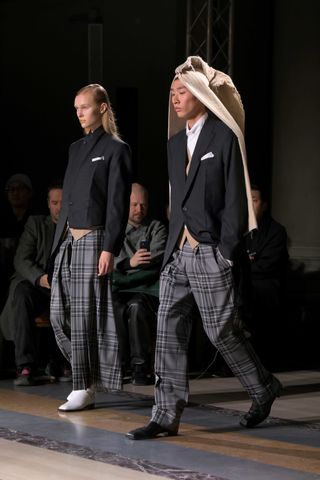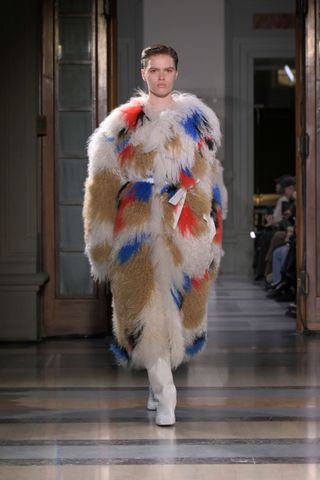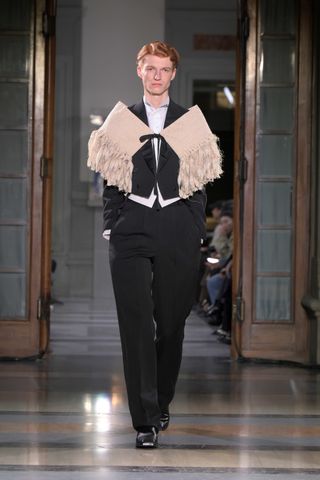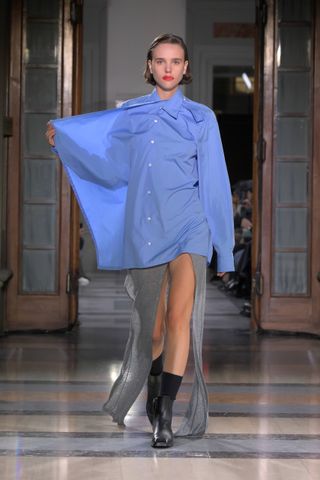‘One factor, infinite potentialities,’ learn the present notes on the Setchu present on Thursday night (16 January 2025) at Pitti Uomo 107 in Florence, a sentiment that not solely defines the design ethos of the burgeoning Milan-based model, however the core motivation of its rising-star founder and artistic director, Satoshi Kuwata.
Within the quick time since he launched his model in 2020, Kuwata has established Setchu as one of the vital intriguing younger labels for its fusion of Kuwata’s native Japanese tradition and the normal Western design codes that he has mastered over the course of a two-decade profession working within the vogue business for labels like Givenchy and Gareth Pugh. In 2023, Setchu would win the distinguished LVMH Prize for Younger Designers.
Setchu’s debut runway present at Pitti Uomo
(Picture credit score: Courtesy of Pitti Uomo)
‘Setchu is the concept of merging issues collectively, fully various things and contrasting objects,’ the designer informed Wallpaper* forward of the debut vogue present for his model that takes its identify from the Japanese time period ‘wayo setchu’, which refers back to the compromise between Japan and the West.
His A/W 2025 assortment started with a chunk of origami paper, which turned the inspiration level behind the sculptural, three-dimensional tailoring, with parts of deconstruction. Safari jackets and peacoats featured origami folds and marble-effect denim jackets had a built-in corset construction. Elsewhere, ribbed-knit cardigans and tabards had been worn with precision-cut ‘hakama’ trousers, ‘haori’ jackets had been introduced in plaid, and ‘The Story of Genji’ was depicted in gold-accented jacquard.
Sitting the viewers in shut proximity to the fashions as they walked across the storied halls of Florence’s Biblioteca Nazionale to the sounds of Purient’s ‘Sagittarius’, the beautiful detailing got here into the highlight as Kuwata revealed his particular model of chic simplicity. ‘Even after I was younger, I actually appreciated the concept of this, much less is extra, wabi sabi,’ he mentioned previous to the present. ‘I feel it is the stability of magnificence that Japan has.’

(Picture credit score: Courtesy of Pitti Uomo)
On the age of 41, Kuwata’s realisation of Setchu is the long-planned manifestation of his life’s work and studying. The designer, who was born in Kyoto, was ‘seven or eight years previous’, when he realised he wished to be a clothier. ‘My aunt was a clothier and so I grew up near the style atmosphere and I had plenty of clothes as my toys,’ he explains. ‘Different [kids] had been doing PlayStation, Nintendo; I used to be enjoying with a jacket and I actually appreciated it, the development of it. It was very regular for me.’
When he was 21, Kuwata left Japan and moved to London to immerse himself in tailoring. ‘It was both going to be Napoli or London to essentially be taught however, ultimately, I went to London as a result of Savile Row is the capital of tailoring,’ he says. The day he arrived he began knocking on doorways asking for a job, however not having the ability to communicate English hindered alternatives.
‘It took me one yr to get a job, clearly as I could not communicate English, so to start with I labored in a Japanese restaurant washing dishes and after that, I went to work for Pret A Manger and discovered my English expertise,’ he says. ‘Six months later, I obtained an intern job at a small tailor referred to as Joe Allen in Islington and that is the place I actually discovered rather a lot within the making of trousers and jackets, all the development.’ Then got here a name from Huntsman & Sons. ‘They heard in regards to the Japanese man working so onerous in Angel and so they approached me.’

(Picture credit score: Courtesy of Pitti Uomo)
It was at Huntsman & Sons the place he fell in love with tailoring. ‘There, my boss informed me, “Satoshi, Savile Row just isn’t draping. It is sculpting. It simply the fabric occurs to be softer. However don’t drape. We’re sculpting, and that is actually the vital factor.” The material is actually gentle, however you’ll want to management it. Controlling can’t simply be accomplished by draping. And that is one thing I actually discovered.’
With the seeds of beginning his personal label firmly sewn, Kuwata modified tack, working with haute-meets-ready-to-wear designer Gareth Pugh, adopted by senior stints at Yeezy with Kanye West, Givenchy with Ricardo Tisci in Paris, Edun and The North Face in New York, after which to Milan to take up a ‘industrial’ inventive director function. Every was a intentionally totally different vogue enterprise each in class and scale in order that he might collect as a lot expertise as attainable, constructing his toolbox to assemble his model.
‘We’ve this proverb in Japan, if you wish to rush, it’s best to go round,’ he says. ‘I knew all through my profession that to have my very own label will price some huge cash. I will be unable to rent CEO or common supervisor to type out the issues, I’ve to type out the issue. I feel operating enterprise is all about finding out the issues. For this reason I wanted to review by working to have the ability to face any scenario.’
‘I used to be considering: I’m in love with double-breasted tailor-made jackets and I am additionally from a rustic which is known for the kimono. How can I mix them collectively?’
Satoshi Kuwata

(Picture credit score: Courtesy of Pitti Uomo)
At 37 years previous in 2020, Kuwata felt able to launch his personal label mid-pandemic. ‘I used to be considering: I’m in love with double-breasted tailor-made jackets and I am additionally from a rustic which is known for the kimono. How can I mix them collectively? After which I got here up with this easy thought of a jacket, however you may fold it like origami, and this was actually the start.’
After twenty years working his approach as much as profitable positions, the expertise, he says, was akin to going again to a pupil’s price range. Then the LVMH Prize got here alongside in 2023, awarding the designer €400,000 to scale his enterprise, a call that was voted for unanimously by the esteemed panel together with Marc Jacobs, Jonathan Anderson, and Delphine Arnault for the primary time in its then-ten-year historical past. The mentorship that got here with it was much more helpful.
‘We’re actually increasing the community sustainably, due to LVMH, and Delphine herself actually cares about us too. That is one thing actually particular,’ says Kuwata. ‘I really feel like I have been taken care of, as if I am like, one of many maisons [that are part of LVMH], and that is undoubtedly greater than the cash they gave.’
‘My dream isn’t just to construct a vogue firm. I feel I wish to construct this type of Setchu-ism’

(Picture credit score: Courtesy of Pitti Uomo)
Quick ahead a yr and a half and Pitti Uomo invited Setchu to be visitor designer at this week’s showcase, after seeing an set up Kuwata labored on with Savile Row’s oldest impartial tailor, Davies & Sons, on the 2024 Venice Biennale. Talking earlier than the present, Kuwata was adamant that it will likely be each his first and final.
‘If all my exterior crew says Satoshi, after this, let’s do one other vogue present, I’ll rethink once more; it’s not my very own determination, as we’re working as a crew. But when I might resolve, I don’t actually see the purpose of doing a vogue present each season as a result of I’m not going to design a garment each season.’
As an alternative, Kuwata is concerned with making a motion. ‘It’s not simply utilized to the style. That is the factor I get actually enthusiastic about as a result of I really like vogue. However my dream isn’t just to construct a vogue firm. I feel I wish to construct this type of Setchu-ism that one thing can apply to life-style.
‘We set the purpose, and now we’re identical to pulled by the facility of this, our inventive path, and that is how I am making an attempt to create,’ he continues, paving the best way for infinite potentialities.
laesetchu.com
What else to count on from Males’s Vogue Weeks A/W 2025
